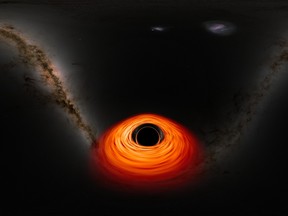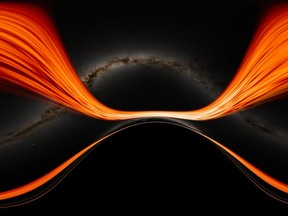Newly released NASA video takes viewers around a black hole — or into one
With a supercomputer and the better part of a week, a NASA scientist delivered a journey into the unknown

Article content
What would it be like to fall into a black hole, the densest object in the universe? A NASA astrophysicist and his trusty supercomputer have provided a stunning answer and even a way to experience it – minus the crushing gravitational forces and certain death that would accompany such a trip.
The videos, which have been uploaded to YouTube in both a flat-screen and 360-degree virtual reality versions, let viewers experience the mind bending (and light bending) visions of either flying around a black hole or, for the more adventurous, plunging directly into one. It is, in a word, trippy.
“People often ask about this, and simulating these difficult-to-imagine processes helps me connect the mathematics of relativity to actual consequences in the real universe,” Jeremy Schnittman, a NASA astrophysicist, said in a press release. “So I simulated two different scenarios, one where a camera — a stand-in for a daring astronaut — just misses the event horizon and slingshots back out, and one where it crosses the boundary, sealing its fate.”
In the first version, the camera approaches what looks to be a jet-black orb, surrounded by a glowing orange ring. As it gets close, the ring seems to stretch and then flip itself inside out, before looping up like a fiery skipping rope suspended in space. In the second, the rope gets thinner and stretches out until it disappears into utter blackness.

In both cases, the object is a supermassive black hole with 4.3 million times the mass of the sun. There’s one just like it at the centre of the Milky Way galaxy. It’s called Sagittarius A* (pronounced “A star”) and is more than 25,000 light years away, or 235 quadrillion kms. Far out.
“If you have the choice, you want to fall into a supermassive black hole,” Schnittman said. (Though in real life, “neither” might be an even better choice.) “Stellar-mass black holes, which contain up to about 30 solar masses, possess much smaller event horizons and stronger tidal forces, which can rip apart approaching objects before they get to the horizon.” This process, by which objects are stretched out like a noodle, gets the scientific term “spaghettification.”
Although there are short versions of the video that let you just watch the camera orbit or enter the black hole, slightly longer clips include more information about exactly what is happening.
The thin inner circle of light is called the photon ring, they explain, and is produced by light that has orbited the black hole before escaping again. It’s a region outside the so-called event horizon, which is the point beyond which nothing, not even light, can escape the black hole’s massive gravity.
In the version in which the camera makes its plunge into the black hole, the video helpfully points out that a real camera would in fact be destroyed, a tiny fraction of a second before reaching the centre, or singularity, of the black hole.
To create the visualizations, Schnittman and fellow NASA scientist Brian Powell used the Discover supercomputer at the agency’s Center for Climate Simulation. The 10 terabytes of data created would have taken more than a decade to process using a standard laptop, but the supercomputer was able to generate the video in just five days, using only a fraction of its computing power.
The simulations also show off the time dilation effects of being near a black hole, with Schnittman pointing out that, in the orbital simulation, a six-hour trip around the black hole would end with the astronaut returning having aged 36 minutes less than her less adventurous colleagues.
“This situation can be even more extreme,” he added. “If the black hole were rapidly rotating, like the one shown in the 2014 movie Interstellar, she would return many years younger than her shipmates.” Good to know that filmmaker Christopher Nolan got his science right on that one.


Postmedia is committed to maintaining a lively but civil forum for discussion. Please keep comments relevant and respectful. Comments may take up to an hour to appear on the site. You will receive an email if there is a reply to your comment, an update to a thread you follow or if a user you follow comments. Visit our Community Guidelines for more information.